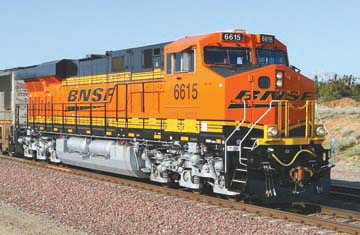
Four Navajo, or Diné, men who were employed by BNSF Railway’s predecessor, Atchison, Topeka & Santa Fe Railway, during the mid-20th century, have filed a lawsuit against the company in the wake of recent health diagnoses they say are directly linked to unsafe working conditions. PHOTO COURTESY TODAY-SCIENCE.COM
LOS LUNAS, NEW MEXICO –– Four Navajo, or Diné, men have filed a lawsuit against Burlington Northern & Santa Fe Railway (formerly the Atchison, Topeka & Santa Fe Railway) saying the railroad company failed to provide adequate safety measures to protect them from respiratory illnesses. The men, who worked for the railroad in the 1940s and 1960s, charge that there was a lack of ventilation in closed cabs and that they were exposed to coal dust, ballast and asbestos fibers while doing physical labor. The former workers – Andrew Ashley, Jimmy Bowman, Jack Gilmore and Hoskie Yonnie – from reservation towns in Arizona and New Mexico have been diagnosed with lung disease. Attorney John Roven, who filed the lawsuit in New Mexico last month, said the men did not file suit earlier because their health problems only became apparent in recent years. “Like all dust-related occupational diseases, the very hallmark of silicosis/pneumoconiosis (lung disease caused by dust inhalation) is a long latency period. Neither X-ray abnormalities nor shortness of breath typically manifest for many years following exposure,” he said in an email. Roven was out of the country at the time this story was reported and unavailable for an in-person interview. An interview was therefore conducted with him via email correspondence. “The men worked with ballast rock that contained a high percentage of quartz, which will produce fibroneic reaction (disease from fibers) in the lungs,” said Roven. “Ballast is the rock that underlies the railroad tracks. They dumped (rocks). They used jackhammers and worked the rock manually and with heavy track machinery. These were not enclosed nor air-filtered at the time. The hallmark symptom of those affected by these conditions is dyspnea (shortness of breath), chronic cough in some cases. It depends on the severity and on individual susceptibility.” Asked if railroad officials knew that conditions were unsafe at the time, Roven said, “We contend that they did. The railroad began supplying breathing protection such as paper masks in the mid-1980s. This is a classic example of closing the barn door after the cow has left. For these men, by then the damaging exposures had already occurred. Current safety procedures have improved, but that’s of little comfort to these men.” Roven has represented other people, including women who have been adversely affected by working conditions on the railroad. “I have represented women who swept the roundhouses and acquired asbestosis (a breathing disorder caused by inhaling asbestos fibers) from working around steam locomotives.” Monetary damages for the workers can be considered under the Federal Employers Liability Act, he said. Roven encourages anyone affected by similar problems while working on the railroad to call his law firm, Roven-Kaplan LLP of Houston, Texas, at (713) 465-8522. He also has enlisted the help of Ann Spencer, a Navajo-speaking assistant, to answer phone calls from Navajo speakers at (928) 313-0287. Asked his reaction to the lawsuit, Joseph Faust, director of public affairs for BNSF Railway, said, “These claims filed are primarily from employees who worked for predecessor railroads many years ago. BNSF is currently reviewing the case and will respond through the legal process.” (Contact Kate Saltzstein at salty223@aol.com)
Join the Conversation
